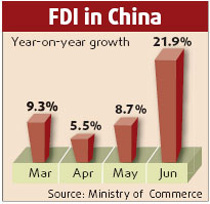Zhang Liqun
Though the consumer price index (CPI) keeps rising rapidly, the producer price index (PPI), a leading indicator of production costs, shows a declining trend. This suggests that the increase in the CPI is mainly the result of price hikes for food. The decline of the growth rate for non-food prices shows that supply and demand are stable, providing the basis for a gradual descent in prices later this year.
According to the National Bureau of Statistics, the PPI grew by 2.4 percent in July, compared with 3.3 percent in January. The PPI growth was 0.2 percentage points higher in August than in July, but the overall trend is still downward.
The slowing growth in the PPI is mainly the result of declining production costs. Though the cost of living rises with food prices, the slowing growth of production costs means an overall trend of slow growth of the PPI.
The rate of CPI growth hit 6.5 percent in August, leading to 3.9 percent year-on-year growth from January to August. Higher food costs have led the faster rate of CPI growth. The prices of industrial consumer goods and services have risen by less than 1 percent this year, while food prices have soared, which has been a major factor in increasing the CPI growth rate.
The relationship between supply and demand affects price levels in the short term. The huge supply potential, together with restricted growth in demand, is a basic reason for the declining growth rate of non-food prices.
The most recent round of economic growth kicked off after the shortage economy was eliminated. In this new phase, output has reached a certain scale, productivity is increasing, the supplies of capital and labor are abundant and the supply of applied technologies is expanding.
As the recent round of reforms takes hold, enterprises' ability to react to market fluctuations will improve. This means the potential to expand production and supply is huge. When there is demand, there will be a corresponding growth in supply.
On the other hand, demand is getting more and more restricted. Since 2003, the central government has tightened its control of land and capital. It has put in place multiple measures, such as raising the threshold to control the unchecked binge on fixed assets investment.
Since last year, the government has controlled the export of energy consuming, polluting and resource-intensive products by lowering tax rebates and collecting export tariffs. It has also tightened control of the export of products affected by trade conflicts. Generally speaking, the control of demand growth has improved.
Having a high supply potential and controlled demand means a coordinated relationship between supply and demand. The possibility of a supply shortage or inflation is slight. What is more, partial oversupply and overcapacity could be possible in the future.
Rising food prices, which have a huge impact on the CPI growth rate, do not mean there is something wrong with agricultural production. Grain production increased every year from 2004 to 2006. That continued this summer, when output saw a 1.3 percent year-on-year increase. The foundation for the grain supply is good.
Four short-term reasons contribute to the rising food prices.
First, world grain production decreased last year, and major producers such as the United States have been using corn to make fuel. Second, the State grain reserve has not caught up with the changing market. Third, the domestic capacity for making ethanol from corn has improved. Fourth, food prices were affected by epidemics and seasonal factors.
Considered from a long-term perspective, these factors reflect a normal trend in economic development. The prices of agricultural and food products will gradually increase with industrialization, urbanization and rises in income levels. This reflects a natural adjustment of industrial-agricultural and urban-rural income distribution patterns. It also means farmers and rural residents are enjoying the fruits of economic growth. Against a background of rapid income increases, such a change will not have a clear impact on the daily lives of most urban families.
Grain prices are stable. The major factors pushing food prices are the higher prices of eggs, meat, poultry and related products. These are mainly short-term issues and the government has been taking various steps to stabilize prices. For example, the government has restricted the development of the bio-energy processing industry, enhanced epidemic prevention and control and established insurance and provided subsidies for pig and poultry farming. With such government support and stimulated by the price hikes, the production scale has expanded.
Of course, the production of such products depends on natural cycles and any increase in supply is destined to be gradual. It is estimated that the changes in supply will be evident by next month. Therefore the growing trend of food prices will peak next month, and then fall. The CPI and PPI growth rates will both see a downward trend.
In conclusion, prices will see a downward change in the future. The PPI growth rate for the whole year will be lower than that of the previous year and the CPI growth will be about 4 percent for this year.
The author is a researcher with the State Council Development Research Center
(China Daily September 28, 2007)


